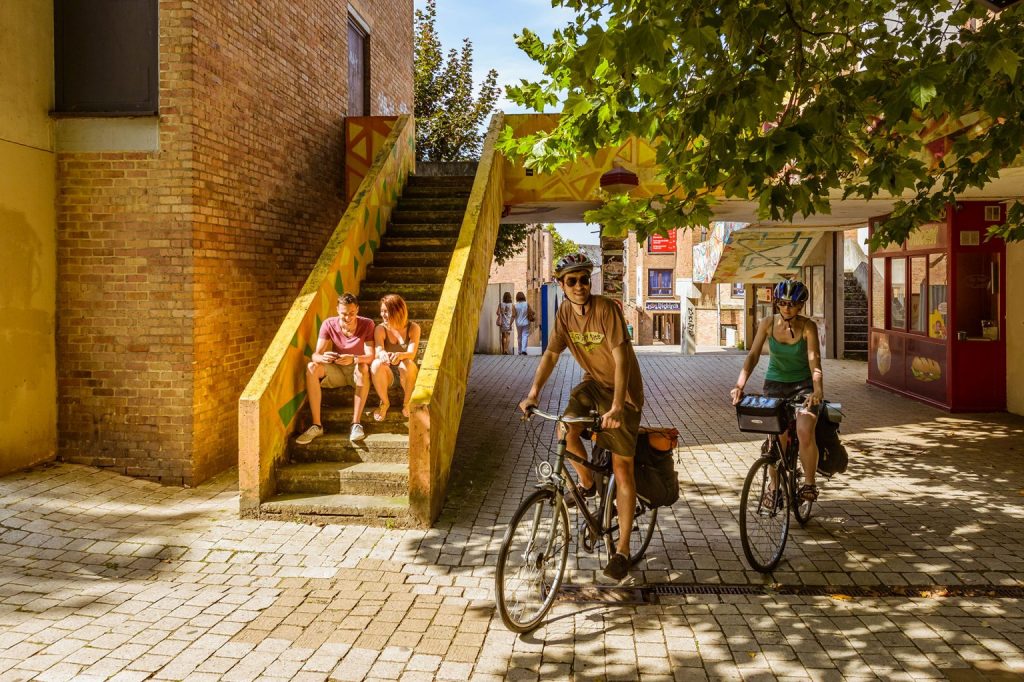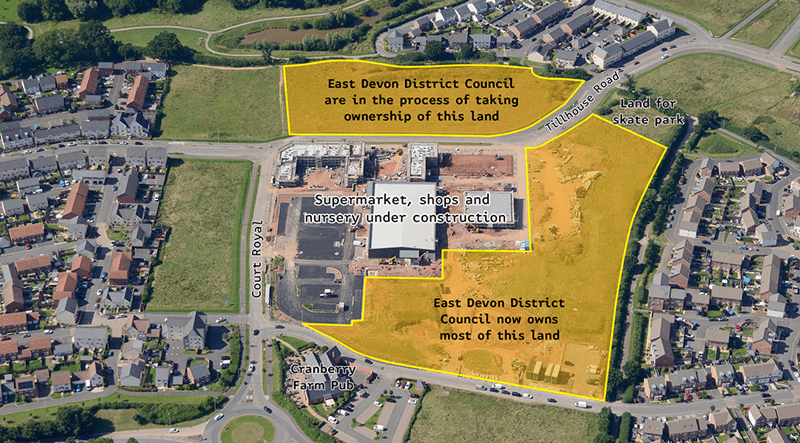Looking beyond ‘cow pat’ development to success stories elsewhere.
A pioneering community-owned shop, in West Sussex, a trailblazing partnership between local developer Thakeham and national charity Plunkett UK.
There are lots of inspiring eco new towns – including Louvain-la-Neuve in Belgium.
.
Last month, the District Council announced the first expansion of Cranbrook in “the largest planning permission issued by EDDC since permission for the new town was issued, more than 13 years ago”.
The only problem is that, over a decade on, it has become “the town without a town centre“.
Residents are still awaiting the building of key facilities, as the Cranbrook Morrisons supermarket opening date remains a mystery – with its store still ‘under review’.
Meanwhile, Persimmon Homes has provided a donation for Cranbrook sport facilities – to the massive tune of £1.5k – “to provide new equipment and expand access to sports around the town”.
And now this over-reliance on developers and estate management firms has led the council to launching a probe into maintaining Cranbrook earlier this month.
In parallel the council have extremely belatedly launched a public competition to help design Cranbrook’s new town centre – all with the promise of another massive prize of £50.
This is not simply disappointing. At its inception, there were high aspirations for the county’s first new town – but it went fairly speedily from an eco newtown to a housing estate.
Or, as the Exeter Digest reported, this became Cranbrook as “cowpat” development:
NOT SUCH AN HONOURABLE MENTION for Cranbrook in a recent Transport for New Homes report examining new housing developments across England to find out whether they are built around sustainable transport or car dependency.
It found that the walkability that was supposed to be at the core of Cranbrook’s claimed sustainability has not come to fruition and residents have no option other than to use a car to access many amenities.
Despite Devon County Council, the local transport authority and bus services commissioner, driving the development forward, researchers found a road that was too narrow for buses to reach a new bus stop. They also found that the much-vaunted railway station, which is more than 550 metres from the nearest housing, is not connected to the main development by bus.
Transport for New Homes classifies Cranbrook as a “cowpat” development: new housing dropped on fields, built separately from the existing urban area to which it is not connected by continuous streets.
HAS THE COUNTY COUNCIL LEARNED ITS LESSON? Judging by the “ample space” for greenfield business park and housing development promoted in the “Clean Growth Vision for the West of East Devon” it commissioned from City Science Corporation (an Exeter City Futures sister company) for submission to the East Devon Local Plan consultation, it seems not.
Worryingly, Devon Council Council says the document “provides the next level of detail beneath the Devon Carbon Plan” and expects it to “inspire other areas to create similar plans”. Get your complimentary Kool-Aid here then consider what this sort of thinking would mean for the new Exeter Local Plan.
Planners and developers are being urged to consider ‘sustainable development’ properly – for example, with the ideas around the 20-minute neighbourhood where services such as shops and sports facilities are within walking/cycling distance.
But is this going to happen in East Devon?
Back in 2021, the council was proposing more new towns for East Devon: but will lessons over Cranbrook be learnt? And once produced a year later, these proposals for a ‘second Cranbrook’ produced a very mixed reaction – most notably, scepticism from locals that the infrastructure would come alongside the housing.
Should the council not be looking at ‘best practice’ – and the humble success stories playing out elsewhere?
There is, for example, the pioneering community shop opening in West Sussex, as reported by the Rural Services Network this week:
The Woodgate Community Shop will operate as a ‘community business’, a not-for-profit business that is owned and run by the local community. The local community can buy a ‘share’ in the business, become a member and have genuine say on how the business runs. Day-to-day the store is run by an employed manager and volunteers, supported by a voluntary committee of local people. The community group is responsible for running the business in the long term, making key governance decisions. Any profit will be invested back into the community to support good causes or community projects.
A pioneering community-owned shop, placed at the heart of Thakeham’s Woodgate development near Pease Pottage in West Sussex, has opened its doors.
The launch is a significant milestone in a trailblazing partnership between leading local developer Thakeham and national charity Plunkett UK. The first of its kind, the newly-opened Woodgate Community Shop has been built by Thakeham and gifted to the community to be run as a community-owned business, for the benefit of residents at Woodgate and Pease Pottage. Thakeham is an industry-leading housebuilder and developer in the south of England, committed to creating sustainable homes and strong communities. Together with Plunkett UK, which specialises in supporting people in rural areas to set up and run successful businesses in community ownership, the two organisations have collaborated to ensure the community has access to help and support to create a flourishing community store. The unique partnership provides a blueprint for creating similar businesses at future Thakeham developments with the shared goal to create sustainable, thriving and inclusive communities.

Finally, there are lots of inspiring eco new towns – including Louvain-la-Neuve in Belgium:
The new town of Ottignies Louvain-la-Neuve reflects the modern trend of ‘greening’ urban areas. The use of cars is limited or even discouraged: pedestrians and bicycles have priority. The fully pedestrianised centre is a prime example of the town’s green character.
…
